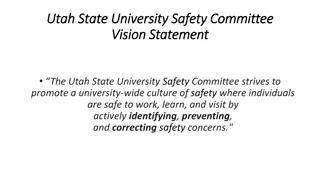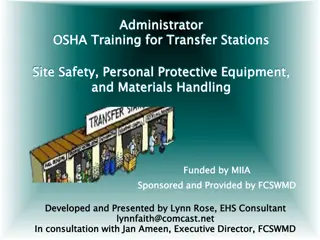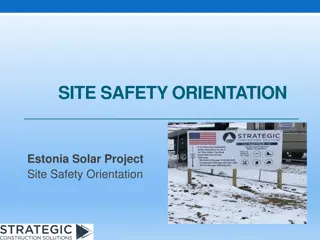The Versatile Machete: History, Uses, and Safety Concerns
The machete, a long broad-bladed knife, serves as a tool for clearing vegetation and as a weapon. Originating from ancient times, it has evolved into a vital tool in various industries such as agriculture, construction, and surveying. Despite its utility, there are significant safety concerns associated with its use, including potential injuries like lacerations and wrist injuries. However, data shows that there have been no fatalities linked to machetes according to OSHA investigations.
Download Presentation

Please find below an Image/Link to download the presentation.
The content on the website is provided AS IS for your information and personal use only. It may not be sold, licensed, or shared on other websites without obtaining consent from the author. Download presentation by click this link. If you encounter any issues during the download, it is possible that the publisher has removed the file from their server.
E N D
Presentation Transcript
Machetes 1
What is a Machete? A machete is a long broad- bladed knife designed for clearing small trees and bushes. It has also been used as a weapon, Often used as a tool to cut through materials such as wood, grass, and shrubbery. The blade is usually 20 to 24 (50 to 60 centimeters) in length and 0.12 in thick 2
History of Machetes Metal machete-like tools date back to the Bronze Age(3000 BC). Made out of bronze, and later iron, these tools were used for cutting herbaceous plant material, small branches, and saplings. The machete has roots that run back to these primitive times, but the tool recognized as a machete did not come about until European villagers began moving from strictly agrarian lifestyles to towns and villages. As smiths became more skilled at honing the edges of knives and weapons, using fire to shape metals, international trade in these finely crafted tools took design to new heights. 3
History of Machetes Spain has been given credit for the first machete as they re-engineered quasi-swords into cutting tools we now recognize as machetes and scythes Tools similar to the machete can be traced back to many cultures from a variety of locations spanning the globe. The common thread being their usage for agricultural purposes. 4
Machetes Today Machetes are most commonly used in agriculture for clearing and harvesting However, they are commonly used in construction for clearing small trees and brush Machetes are often used by surveyors in the Construction Industry: Cut trails and boundaries Clear areas for placing surveying stations, clear lines of sight, etc. 5
Major Safety Concerns Areas where machetes are used can be dangerous as snakes, ticks, and poison ivy may be present Operator being injured by being distracted Loose handle which could lead to blade coming off Defective blade breaking off The machete slipping from the operators hand 6
Major Safety Concerns Common Injuries Due to Machetes: Lacerations Rotator Cuff Injury Wrist Injury Back Injury 7
Fatalities & Injuries There were no fatalities associated with machetes in the OSHA fatality investigation data 1990-2009. Source: Extracted from OSHA Accident Investigation Data 1990-2009 8
OSHA Regulations 1926.604 Site Clearing (a) General requirements (1) Workers engaged in site clearing must have protection from plants, insects, and animals that may be hazardous. They must also know first aid for these hazards. The use of machetes is not specifically addressed by the OSHA regulations. Source: OSHA 29 CFR 1926 Construction Industry Regulations 9
Personal Protective Equipment Safety Glasses Hard Hat Steel-Toed Boots Gloves Long Pants 10
Safety Practices Prior to use, inspect the machete for loose fasteners. Ensure that the machete is sharp. Inspect the area to be cleared. Notify others in the area of the work being done 11
Safety Precautions Never use a machete in close proximity of another person. It is important to never work alone to ensure quick medical attention can be sought if an injury occurs. Always cut away from the body Always strike at a 45 degree angle When not using the machete it should be placed in a sheath or case to protect anyone from the exposed blade 12
Safety Procedures Install a sabre-type hand guard on the machete. This will help prevent the tool from accidently being thrown during a swing. Sharpen the machete to assure a clean bite. The blade should not be sharpened for the first six inches from the handle nor the last two inches from the point. A sharp blade is a safe blade, preventing injury and fatigue. Clear the swing area prior to advancing through a brushy area. An interrupted swing could deflect and could result in injury. Do not hit the ground with the machete. The flexible blade could recoil from the impact, resulting in an injury. 13
Think Safety Work Safely 14

















































